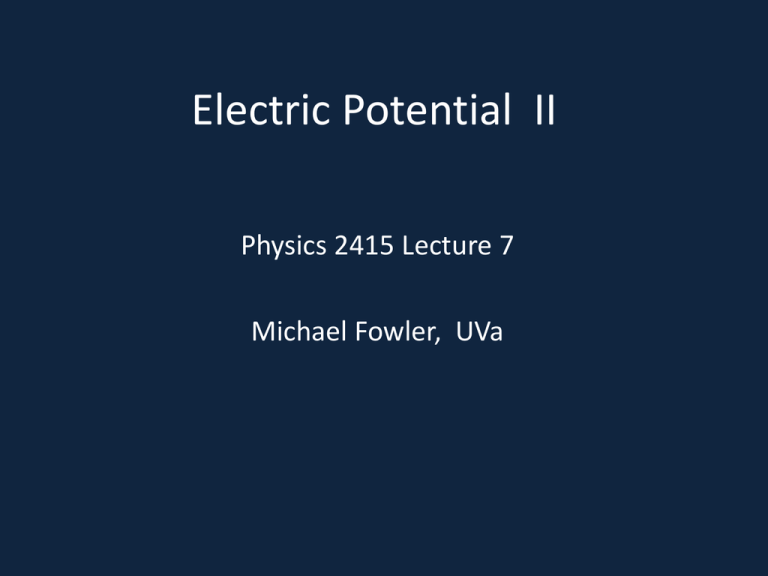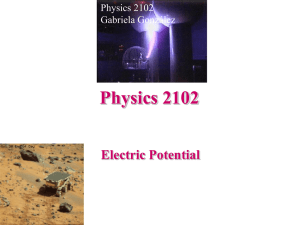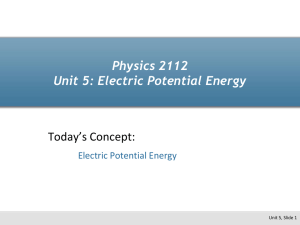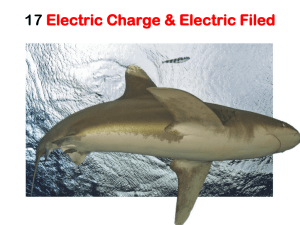Electric Potential II - Galileo and Einstein
advertisement

Electric Potential II Physics 2415 Lecture 7 Michael Fowler, UVa Today’s Topics • • • • Field lines and equipotentials Partial derivatives Potential along a line from two charges Electric breakdown of air Potential Energies Just Add • Suppose you want to bring one charge Q close to two other fixed charges: Q1 and Q2. • The electric field Q feels is the sum of the two fields from Q1, Q2, the work done in moving d is E d • a y r1 Q Q1 r r2 E1 d E 2 d so since the potential energy change along a path is work done, V r V1 r V 2 r Q2 0 x Q1 Q 2 V r 4 0 r1 r2 1 Total Potential Energy: Just Add Pairs • If we begin with three charges Q1, Q2 and Q3 initially far apart from each other, and bring them closer together, the work done—the potential energy stored—is Q1Q 2 Q 2 Q 3 Q 3 Q1 U 4 0 r12 r23 r31 1 and the same formula works for assembling any number of charges, just add the PE’s from all pairs—avoiding double counting! • a Q3 r23 r13 Q1 r12 Q2 Equipotentials • Gravitational equipotentials are just contour lines: lines connecting points (x,y) at the same height. (Remember PE = mgh.) • It takes no work against gravity to move along a contour line. • Question: What is the significance of contour lines crowding together? Electric Equipotentials: Point Charge • The potential from a point charge Q is V r 1 Q 4 0 r • Obviously, equipotentials are surfaces of constant r: that is, spheres centered at the charge. • In fact, this is also true for gravitation—the map contour lines represent where these spheres meet the Earth’s surface. Plotting Equipotentials • Equipotentials are surfaces in three dimensional space—we can’t draw them very well. We have to settle for a two dimensional slice. • Check out the representations here. Plotting Equipotentials • . Here’s a more physical representation of the electric potential as a function of position described by the equipotentials on the right. Given the Potential, What’s the Field? • Suppose we’re told that some static charge distribution gives rise to an electric field corresponding to a given potential V x , y , z . • How do we find E x , y , z ? • We do it one component at a time: for us to push a unit charge from x , y , z to x x , y , z takes work E x x , and increases the PE of the charge by V x x , y , z V x , y , z . • So: Ex V x x, y, z V x, y, z x V x , y , z x for x 0. What’s a Partial Derivative? • The derivative of f(x) measures how much f changes in response to a small change in x. • It is just the ratio f/x, taken in the limit of small x, and written df/dx. • The potential function V x , y , z is a function of three variables—if we change x by a small amount, keeping y and z constant, that’s partial differentiation, and that measures the field component in the x direction: Ex V x, y , z x , Ey V x, y , z y , Ez V x, y , z z . Field Lines and Equipotentials • The work needed to move unit charge a tiny distance d at position r is E r d . • That is, V r d V r E r d • Now, if d is pointing along an equipotential, by definition V doesn’t change at all! • Therefore, the electric field vector E r at any point is always perpendicular to the equipotential surface. Potential along Line of Centers of Two Equal Positive Charges • D V(x) Q 0 Q Note: the origin (at the midpoint) is a “saddle point” in a 2D graph of the potential: a high pass between two hills. It slopes downwards on going away from the origin in the y or z directions. x Potential along Line of Centers of Two Equal Positive Charges V(x) Q 0 Q x • Clicker Question: • At the origin in the graph, the electric field Ex is: A. maximum (on the line between the charges) B. minimum (on the line between the charges) C. zero Potential along Line of Centers of Two Equal Positive Charges V(x) Q 0 Q x • Clicker Answer: V Ex(0) = Zero: because E x equals minus the slope. x • (And of course the two charges exert equal and opposite repulsive forces on a test charge at that point.) Potential and field from equal +ve charges • . • . Potential along Bisector Line of Two Equal Positive Charges Q a V(y) r y 0 a Now plotting potential along the y-axis, not the x-axis! Q • For charges Q at y = 0, x = a and x = -a, the potential at a point on the y-axis: V y 2 kQ r 2 kQ a y 2 2 Note: same formula will work on axis for a ring of charge, 2Q becomes total charge, a radius. Potential from a short line of charge • Rod of length 2 has uniform charge density , 2 = Q. What is the potential at a point P in the bisector plane? • The potential at y from the charge between x, x + x is kQ x k x r k x x y 2 r • . P r y 2 • So the total potential x V y k dx x y 2 2 kQ 2 2 y 2 y ln 2 2 Great – but what does V(y) look like? Potential from a short line of charge V k dx y x y 2 2 kQ 2 2 y 2 y ln 2 2 • What does this look like at a large distance y ? • Useful math approximations: for 1 1 x 1 x , ln 1 x x small x, • So 2 y 2 y 2 2 y y 1 / y 1 / y • . y 1 2 / y x • And V y kQ 2 ln 1 2 / y kQ y Bottom line: at distances large compared with the size of the line, it looks like a point charge. Potential from a long line of charge • Let’s take a conducting cylinder, radius R. • If the charge per unit length of cylinder is , the external electric field points radially outwards, from symmetry, and has magnitude E(r) = 2k/r, from Gauss’s theorem. r • So V r V R r E r dr V R 2 k R R dr r V R 2 k ln r ln R . • Notice that for an infinitely long wire, the potential keeps on increasing with r for ever: we can’t set it to zero at infinity! Potential along Line of Centers of Two Equal but Opposite Charges • D V(x) Q 0 -Q x Potential along Line of Centers of Two Equal but Opposite Charges V(x) • D Q 0 -Q x Clicker Question: At the origin, the electric field magnitude is: A. maximum (on the line and between the charges) B. minimum (on the line and between the charges) C. zero Potential along Line of Centers of Two Equal but Opposite Charges V(x) • D Q 0 -Q x Clicker Answer: At the origin in the above graph, the electric field magnitude is: minimum (on the line between the charges) • Remember the field strength is the slope of the graph of V(x): and between the charges the slope is least steep at the midpoint. Charged Sphere Potential and Field • For a spherical conductor of radius R with total charge Q uniformly distributed over its surface, we know that E r 1 Q rˆ 4 0 r 2 and V r 1 Q 4 0 r . • The field at the surface is related to the surface charge density by E = /0. • Note this checks with Q = 4πR2. Connected Spherical Conductors • a • Two spherical conductors are connected by a conducting rod, then charged—all will be at the same potential. • Where is the electric field strongest? A. At the surface of the small sphere B. At the surface of the large sphere C. It’s the same at the two surfaces. Connected Spherical Conductors • Two spherical conductors are connected by a conducting rod, then charged—all will • a be at the same potential. • Where is the electric field strongest? A. At the surface of the small sphere. • Take the big sphere to have radius R1 and charge Q1, the small R2 and Q2. • Equal potentials means Q1/R1 = Q2/R2. • Since R1 > R2, field kQ1/R12 < kQ2/R22. • This means the surface charge density is greater on the smaller sphere! Electric Breakdown of Air • Air contains free electrons, from molecules ionized by cosmic rays or natural radioactivity. • In a strong electric field, these electrons will accelerate, then collide with molecules. If they pick up enough KE between collisions to ionize a molecule, there is a “chain reaction” with rapid current buildup. • This happens for E about 3x106V/m. Voltage Needed for Electric Breakdown • Suppose we have a sphere of radius 10cm, 0.1m. • If the field at its surface is just sufficient for breakdown, 3 10 6 • The voltage V 1 Q 4 0 R 1 Q 4 0 R 2 3 10 R 300, 000V 6 • For a sphere of radius 1mm, 3,000V is enough— there is discharge before much charge builds up. • This is why lightning conductors are pointed!











